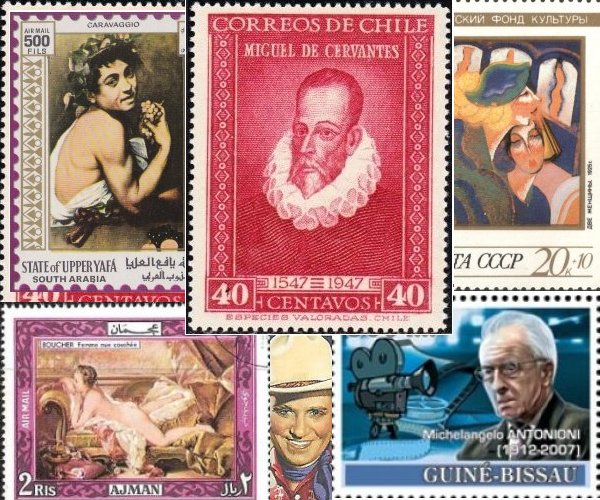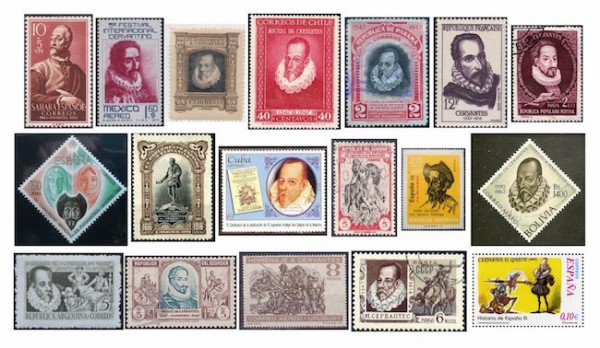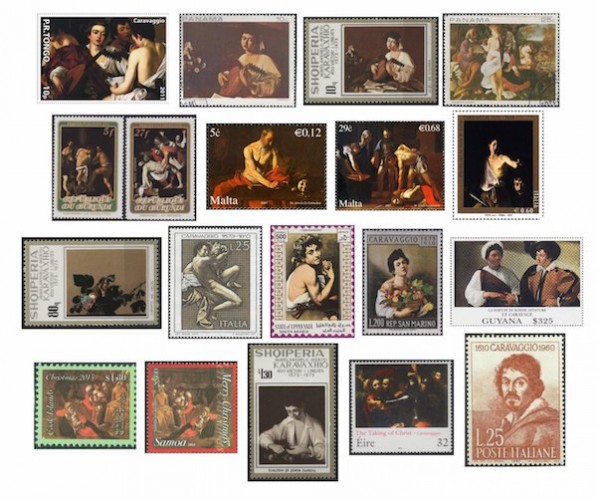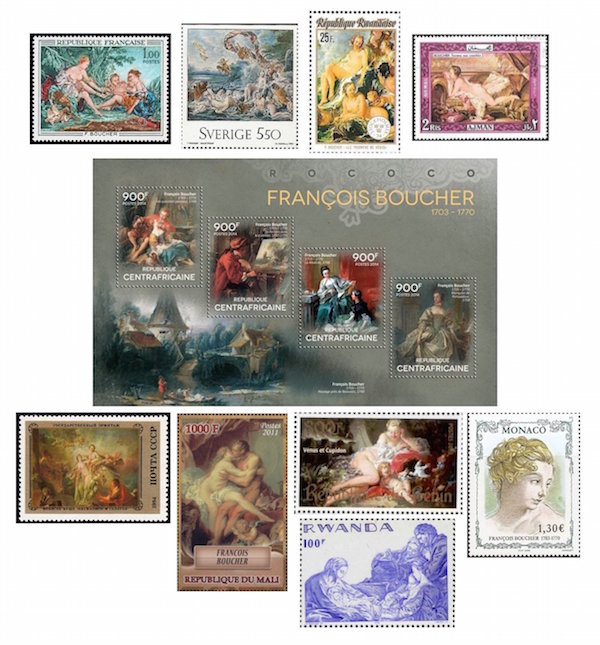The Arts on Stamps of the World — September 29
An Arts Fuse regular feature: the arts on stamps of the world.

By Doug Briscoe
Three great figures stand tall today, as it is the birthday of Cervantes (probably), Caravaggio, and Antonioni. We have also François Boucher, Gene Autry, and the usual assortment of talented artists whose work may be new to you.
Giant among giants, Miguel de Cervantes Saavedra is thought to have been born on 29 September 1547 (d. 22 April 1616). His Don Quixote has inspired legions of composers, writers, artists, and filmmakers for generations. Among many others, there are operas by Paisiello (1769), Salieri (1771), Dittersdorf (1795), Mendelssohn (Die Hochzeit des Camacho, 1825), Mercadante (1830), Kienzl (1897), Massenet (1910), Falla (El retablo de maese Pedro, 1923), and Cristóbal Halffter (premièred 2000), an operetta by Heuberger (1910), ballets by Boismortier (1743), Minkus (1869), Ibert (Le Chevalier Errant) and Roberto Gerhard (both 1950), incidental music by Purcell, an orchestral suite by Telemann, a piano suite by Korngold (1908), and, of course, the great tone poem by Richard Strauss (1897). In addition to Cervantes stamps from Spain and its colonies, there are examples from almost every country in South America, Mexico, Cuba, Panama, and so on, along with issues from France (top row, second from right), Romania (top right), and the USSR (next to last). (I’m quite surprised there isn’t a German one yet.) The final stamp shown is the most recent of all, a Spanish one from 2002 offering a Don Quixote caricature.

Again, the multitudes of stamps for the great painters, in today’s case Caravaggio and Boucher, make it difficult for me to winnow down the selection to a manageable group. We begin the collage for Michelangelo Merisi (or Merigi or Amerighi) da Caravaggio (29 September 1571 – 18 July 1610) with three musical pictures. There are a Togolese stamp of The Musicians (1595-6); two versions of The Lute Player (c1596), one from Panama, one from Albania; and another Panamanian issue, The Flight into Egypt (c1586), in which an angel plays the violin to the Holy Family. The second row consists entirely of religious paintings, including, second from left, The Entombment of Christ (1602-03) on a stamp of Burundi and, at far right, an Italian stamp of David with the Head of Goliath (c1610) (Caravaggio had made another painting on the same subject in 1606 or 1607. Highlights of row three are, at left, a rare still life, Basket of Fruits (c1595-96), in the center, the famous Young Sick Bacchus (1593), next to that Boy with a Basket of Fruit (1593-94, stamp of San Marino), and, last in the row, the second version (c1595) of The Fortune Teller (cf. the first version of c1594). The bottom row begins with two stamps offering Caravaggio’s Adoration of the Shepherds (1609; the Samoan stamp shows the image reversed), The Taking of Christ (1602), Boy Peeling Fruit (1592-3), and a chalk portrait of the artist by Ottavio Leoni, dated about 1621, on a 1960 Italian stamp marking the sesquicentennial of Caravaggio’s death.
François Boucher (29 September 1703 – 30 May 1770) represents the essence of the taste of the French Rococo. The first stamp is a French one: Diana Returning from the Hunt (1745). Next to it, on a stamp from Sweden, is The Triumph of Venus (1740). A detail from the same work shows up on a stamp from Ajman, and at the right is one of Boucher’s most familiar pieces, believed to be a portrait of Marie-Louise O’Murphy, mistress to Louis XV (c1752). The souvenir sheet from the Central African Republic collects Autumn Pastoral (1749), The Painter in His Study (c1730-35), La Modiste (c1746), and one of Boucher’s portraits of Madame de Pompadour (1759), with Landscape Near Beauvais (1740) as a backdrop. In the bottom row the Russian stamp is of Pygmalion and Galatea (1767), the Malian one is Hercules And Omphale (1735), the Beninese one is Venus and Cupid (1742), the Rwandan monochrome stamp is of The Light of the World (Nativity) (1750). I was unable to identify the source of the 2003 stamp from Monaco.

I hope you aren’t sated with painters, because we have more four more of them in a row to consider. One of much less renown was the Slovak artist Peter Michal Bohúň (29 September 1822 –20 May 1879). Caught up in the fervor of revolution, he supported the movement for Slovak independence and studied law, painting at first only as an avocation. In 1843, he committed to the arts by entering the Prague Academy. He left mainly portraits, as in the ones reproduced on the three Czech stamps, but also landscapes and altarpieces. The stamps show two portraits of the writer Ján Francisci, the second titled Ján Francisci as a Volunteer (both from 1850) on either side of a portrait of an anonymous Seated Woman.
Also rather obscure (sorry) is the Australian painter with the rather silly name of Rupert Bunny (whose school days must have been pretty rough). Born in this day in 1864, he studied in London and Paris. His portrait of soprano Nellie Melba was used to celebrate her sesquicentennial in 2011. Some of his other work is redolent of the Pre-Raphaelites, as in Pastorale (1893) and Summer Time (c1907), while others, like Endormies (c1904) and The Rape of Persephone (1913), look more to Impressionism. Bunny died on 25 May 1947.
The father of Hungarian modernist Hugó Scheiber (September 29, 1873 – March 7, 1950) painted backdrops for a theater in Vienna, where Hugó grew up from the age of eight. At fifteen the family returned to Scheiber’s birthplace of Budapest, where he studied at the School of Design. Scheiber moved from post-Impressionism to German Expressionism and Futurism, with an inclination to Art Deco. He moved to Berlin in 1922, and his success led to exhibitions in London, Rome, La Paz, and New York. With the accession to power of the Nazis Scheiber again returned to his homeland. He loved painting the modern urban life. His work Two Women (1925), showing a pair of contemporary flappers, appears on a Soviet stamp of 1989.
The last, chronologically, of today’s painters is Ian Fairweather (29 September 1891 – 20 May 1974), born in Scotland but resident in Australia and seen as one of the very finest of that country’s artists. His parents left for India when he was a baby and didn’t see him again until he was ten. Sounds as if he may have been better off. His travails were not over, though. He was a prisoner of war for almost the entire duration of World War I. But at least his captors allowed him to study drawing and Japanese, and he contributed illustrations to POW magazines. After the war he continued his studies of art and of Japanese in the Netherlands, London, and Munich. He traveled much and was one of the artists to visit Lina Bryans’s artists’ colony Darebin Bridge House in Melbourne (of which we spoke here just three days ago). During the Second World War he was in the army again, didn’t get captured this time, and afterwards repaired to a catch-as-catch-can existence on the north coast of Australia. At one point he built a raft and sailed out to sea and was thought to have been lost, but he landed in Indonesia. His work, showing a significant Oceanian influence, inclines to the abstract, as in Last Supper and Kite Flying, which is shown on the Australian stamp of 1995. Both paintings were created in 1958.

The most famous work of German architect Egon Eiermann (29 September 1904 – 20 July 1970) is the rebuilding of the Kaiser Wilhelm Memorial Church in Berlin (1959-63), the structure shown on the stamp issued for Eiermann’s centenary in 2004. The church suffered bombing damage during an air raid on 23 November 1943. Most of the old spire was retained, but the rest of the original building was torn down and a new belfry added. Eiermann’s other important works include the coterminous West German embassy in Washington, D.C. (1958-64), IBM-Germany Headquarters in Stuttgart (1967-72), and the Olivetti building in Frankfurt (1968-72).
Cowboy singer Gene Autry (September 29, 1907 – October 2, 1998) is the only person to have five stars on the Hollywood Walk of Fame, one for each of the five categories: film, television, music, radio, and live performance. His nearly 100 movies and his fifties TV show introduced many Americans to country music, and he is considered the most influential country singer after Jimmie Rodgers. He was involved in both rodeo and radio, served in World War II as a technical sergeant and transport pilot, and owned the Angels baseball team from 1961 to 1997.
Hailed as one of the great film directors, Michelangelo Antonioni (29 September 1912 – 30 July 2007) is especially known for directing L’Avventura (1960), La Notte (1961), and L’Eclisse (1962), as well as his first English-language film, Blowup (1966), with David Hemmings and Vanessa Redgrave. As a child Antonioni loved drawing and music and was a more than able violinist. He turned to cinema in his teens, abandoning the violin, but he never gave up drawing. He worked as an assistant director and maker of shorts during the war, when he nearly escaped being executed as a member of the resistance. His first feature was 1950’s Cronaca di un amore (Story of a Love Affair), based on James M. Cain’s novel The Postman Always Rings Twice. Antonioni is remembered on a stamp of Guinea-Bissau.

Another much-admired filmmaker was the American Stanley Kramer (September 29, 1913 – February 19, 2001), who gave us more than a few favorite American movies, typically delivering a social comment: The Defiant Ones (1958), On the Beach (1959), Inherit the Wind (1960), Judgment at Nuremberg (1961), Ship of Fools (1965), and Guess Who’s Coming to Dinner (1967). He produced a number of other significant pictures, including Cyrano de Bergerac (1950), The Caine Mutiny (1954), and the one recalled on the Monegasque stamp, High Noon, where its title is rendered as Le train sifflera trois fois (The Train Whistles Three Times).
Since we mentioned La dolce vita yesterday in connection with Marcello Mastroianni’s birthday, it seems fitting to salute his late co-star in that film, Swedish actress Anita Ekberg (29 September 1931 – 11 January 2015) today. (Mastroianni, of course, was also the star of Antonioni’s La Notte, mentioned above.) September 29 is also the birthday of English novelist Elizabeth Gaskell (née Stevenson; 1810 – 12 November 1865), and I’d like to add happy birthday to American TV composer Mike Post (born Leland Michael in 1944), just because I think his theme music for Law & Order (the original show) is awfully damn good. They don’t write ‘em like that any more.
A graduate of the University of Massachusetts with a B.A. in English, Doug Briscoe worked in Boston classical music radio, at WCRB, WGBH, and WBUR, for about 25 years, beginning in 1977. He has the curious distinction of having succeeded Robert J. Lurtsema twice, first as host of WGBH’s weekday morning classical music program in 1993, then as host of the weekend program when Robert J.’s health failed in 2000. Doug also wrote liner notes for several of the late Gunther Schuller’s GM Recordings releases as well as program notes for the Boston Classical Orchestra. For the past few years he’s been posting a Facebook “blog” of classical music on stamps of the world, which has now been expanded to encompass all the arts for The Arts Fuse.
